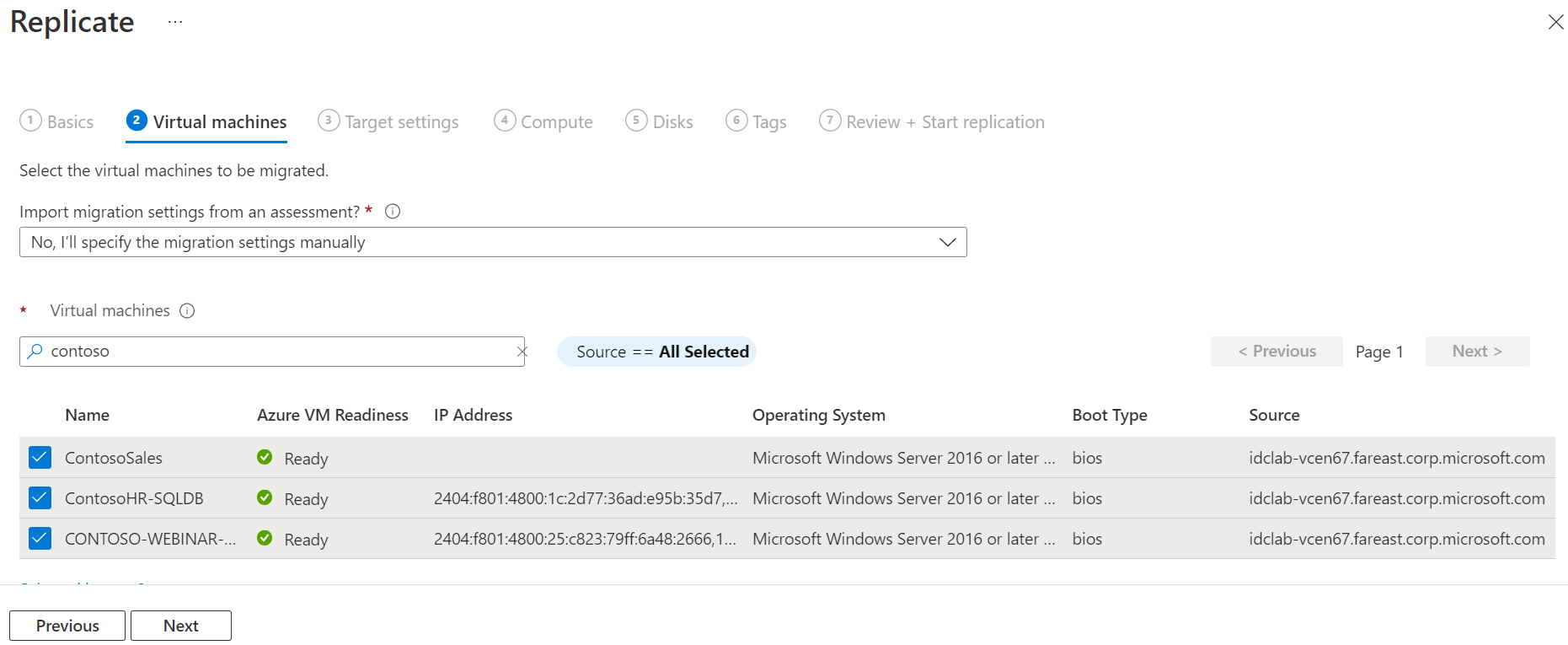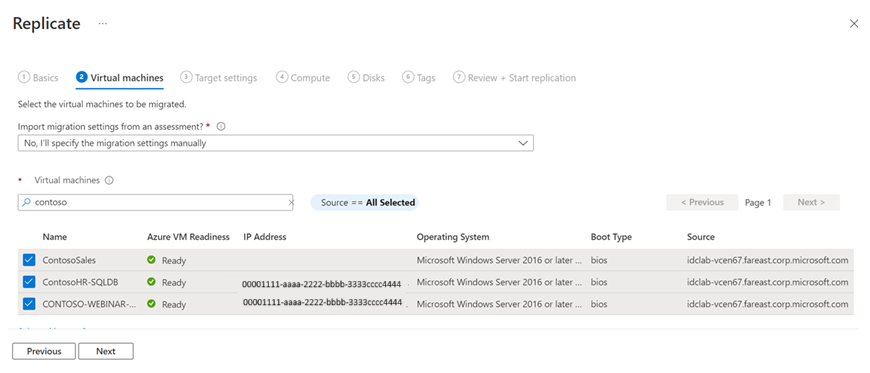Note
Access to this page requires authorization. You can try signing in or changing directories.
Access to this page requires authorization. You can try changing directories.
This article shows you how to migrate machines as physical servers to Azure by using the Azure Migrate: Server Migration tool. Migrating machines by treating them as physical servers is useful in many scenarios:
Migrate on-premises physical servers.
Migrate virtual machines (VMs) virtualized by platforms such as Xen and KVM.
Migrate Hyper-V or VMware VMs, if you're unable to use the standard migration process for Hyper-V or VMware agentless migration.
Migrate VMs running in private clouds.
Migrate VMs running in public clouds, such as Amazon Web Services (AWS).
In this tutorial, you learn how to:
- Prepare Azure with required permissions to use Azure Migrate.
- Check requirements for machines you want to migrate. Prepare a machine for the Azure Migrate and Modernize replication appliance that's used to discover and migrate machines to Azure.
- Set up the replication appliance.
- Install the Mobility service on machines you want to migrate.
- Enable replication.
- Run a test migration to make sure everything's working as expected.
- Run a full migration to Azure.
Note
Tutorials show you the simplest deployment path for a scenario so that you can quickly set up a proof of concept. Tutorials use default options where possible and don't show all possible settings and paths. For detailed instructions, review the how-to articles for Azure Migrate and Modernize.
If you don't have an Azure subscription, create a trial subscription before you begin.
Prerequisites
Before you begin this tutorial, you should:
- Review the migration architecture.
- Review the limitations related to migrating Windows Server 2008 servers to Azure.
Note
If you're planning to upgrade your Windows operating system, Azure Migrate and Modernize might download the Windows SetupDiag utility for error details in case upgrade fails. Ensure that the VM created in Azure after the migration has access to SetupDiag. If there's no access to SetupDiag, you might not be able to get detailed OS upgrade failure error codes but the upgrade can still proceed.
Prepare Azure
Prepare Azure for migration with the Azure Migrate: Server Migration tool.
| Task | Details |
|---|---|
| Create an Azure Migrate project | Your Azure account needs Contributor or Owner permissions to create a new project. |
| Verify permissions for your Azure account | Your Azure account needs permissions to create a VM and write to an Azure managed disk. |
Assign permissions to create a project
In the Azure portal, open the subscription and select Access control (IAM).
In Check access, find the relevant account and select it to view permissions.
You should have Contributor or Owner permissions.
- If you just created a trial Azure account, you're the owner of your subscription.
- If you're not the subscription owner, work with the owner to assign the role.
Assign Azure account permissions
Assign the VM Contributor role to the Azure account. This role provides permissions to:
- Create a VM in the selected resource group.
- Create a VM in the selected virtual network.
- Write to an Azure managed disk.
Create an Azure network
Important
Virtual networks are a regional service, so make sure you create your virtual network in the desired target Azure region. For example, if you're planning on replicating and migrating VMs from your on-premises environment to the China East Azure Region, your target virtual network must be created in the China East Region. To connect virtual networks in different regions, see Virtual network peering.
Set up an Azure virtual network. When you replicate to Azure, Azure VMs are created and joined to the Azure virtual network that you specified when you set up migration.
Prepare for migration
Note
We recommend that you perform discovery and assessment prior to the migration by using the Azure Migrate: Discovery and assessment tool, a separate lightweight Azure Migrate appliance. You can deploy the appliance as a physical server to continuously discover servers and performance metadata. Learn more.
To prepare for physical server migration, you need to verify the physical server settings and prepare to deploy a replication appliance.
Check machine requirements for migration
Make sure machines comply with requirements for migration to Azure.
Note
When you migrate physical machines, the Azure Migrate: Server Migration tool uses the same replication architecture as agent-based disaster recovery in Azure Site Recovery. Some components share the same code base. Some content might link to Site Recovery documentation.
Verify physical server requirements.
Verify that on-premises machines that you replicate to Azure comply with Azure VM requirements.
Some changes are needed on VMs before you migrate them to Azure:
Prepare a machine for the replication appliance
The Azure Site Recovery Replication appliance is used to replicate machines to Azure. Learn more.
To set up a new appliance, you can use PowerShell installer script. Ensure you meet all the hardware and software requirements, and any other prerequisites.
Note
The replication appliance shouldn't be installed on a source machine that you want to replicate or on the Azure Migrate: Discovery and assessment appliance you might have installed before.
Set up the replication appliance
The first step of migration is to set up the replication appliance. To set up the appliance for physical server migration, download the installer file for the appliance. Then run it on the machine you prepared. After you install the appliance, register it with your migrate project using the key copied from the portal.
Classic experience (Retiring)
Note
Classic experience is scheduled for retirement on 30 September 2026. Final recovery point for replications will be on 31 May 2026. Support for migrations will continue until the retirement date. Switch sooner to gain the richer benefits of simplified experience. Learn more on how to set up the Simplified Experience.
Download the replication appliance installer
In the Azure Migrate project, select Windows, Linux and SQL Server > Azure Migrate: Server Migration > Discover.
In Discover machines > Are your machines virtualized?, select Not virtualized/Other.
In Target region, select the Azure region to which you want to migrate the machines.
Select Confirm that the target region for migration is region-name.
Select Create resources to create a Site Recovery vault in the background.
- If you already set up migration with the Azure Migrate: Server Migration tool, the target option can't be configured because resources were set up previously.
- You can't change the target region for this project after selecting this button.
- All subsequent migrations are to this region.
In Do you want to install a new replication appliance?, select Install a replication appliance.
In Download and install the replication appliance software, download the appliance installer and the registration key. You need the key to register the appliance. The key is valid for five days after it was downloaded.
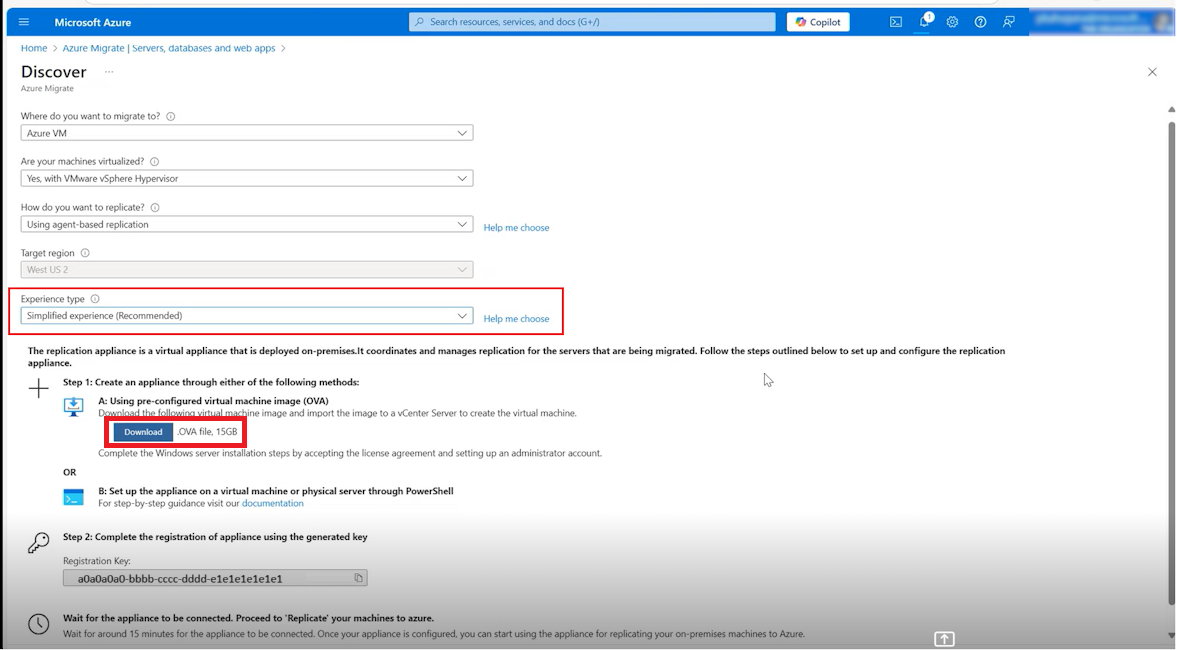 .
.Copy the appliance setup file and key file to the Windows Server 2016 machine you created for the appliance.
After the installation finishes, the Appliance configuration wizard launches automatically. (You can also launch the wizard manually by using the
cspsconfigtoolshortcut that was created on the appliance desktop.) In this tutorial, we manually install the Mobility service on the source VMs to be replicated. You need to create a dummy account in this step to proceed. For your dummy account, use "guest" as the friendly name, "username" as the username, and "password" as the password for the account. You use this dummy account in the Enable Replication stage.After the appliance restarts after setup, in Discover machines, select the new appliance in Select Configuration Server. Then select Finalize registration. The Finalize registration step performs a couple of final tasks to prepare the replication appliance.

The mobility service agent must be installed on the servers to get them discovered by using the replication appliance. Discovered machines appear in Azure Migrate: Server Migration. As VMs are discovered, the Discovered servers count rises.
Simplified experience (Recommended)
This section introduces a new process, which is simplified experience. Users will follow a streamlined flow that begins with discovery, followed by replication, and finally migration.
It introduces an upgraded agent-based migration stack for physical and VMware environments. Customers benefit from the ability to migrate newer Linux distributions to Azure, use WS2022 for the replication appliance, and utilize a unified OS support matrix.
Navigate to Azure Migrate project
Follow the steps to navigate to the Azure Migrate project:
Step 1: Navigate to Azure Migrate project
Open Azure portal.
Search for the Azure Migrate service.
Create a new project or select an existing one. Learn more.
Step 2: Select the required Agent-Based Migration Scenario
Select Discover from the Migration tools.
Select the scenario VMware agent-based replication or Physical or other.
If resources aren't already created, select a target region for your migration and create the resources.
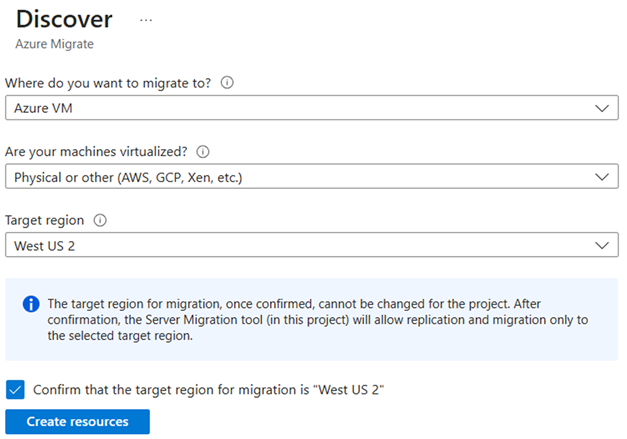 .
.- If you already set up migration with the Azure Migrate: Server Migration tool, the target option can't be configured because resources were set up previously.
- You can't change the target region for this project after selecting this button.
- All subsequent migrations are to this region.
Select Simplified experience from the Experience type dropdown.
Note
For more detailed information on deploying the appliance, refer to the appendix section at the end of this document.
Step 3: Deploy the Appliance
Follow the steps with OVA or PowerShell for VMware and PowerShell for the physical scenario.
After deployment and completing the registration key process, wait for 30 minutes for the appliance to connect.
Step 4: Start the Replication
Select Replicate.
Select the appropriate scenario (Physical or VMware agent-based) and proceed.
Select the VMs you want to replicate and configure the target settings.
Step 5: Test migrate and Migrate
Navigate to the migration overview page.
Select Test Migrate and perform test migration on the machines you want to migrate.
After successful test migration, Perform the final migration.
Step 6: Verify the virtual machine in Azure VM
Verify if the VM boots up on Azure:
- By going to the target resource group and searching for your VM.
- Or by navigating to the Azure VM section on the Azure portal and searching for your migrated VM.
Set up the replication appliance using the Powershell script for VMware agent-based migration
Set up the appliance using PowerShell
If your organization has restrictions, you can manually set up the replication appliance using PowerShell. For physical servers, use PowerShell to install the appliance.
Follow these steps:
- Download the installers and place them on the replication appliance.
- Unzip and extract the components.
- Execute the DRInstaller.ps1 PowerShell script as an administrator.
Register appliance
After the appliance is created, the Azure Appliance Configuration Manager launches automatically. It validates prerequisites such as internet connectivity, time synchronization, system configurations, and group policies.
CheckRegistryAccessPolicy - Prevents access to registry editing tools
- Key: HKLM\SOFTWARE\Microsoft\Windows\CurrentVersion\Policies\System.
- The DisableRegistryTools value shouldn't be equal to 0.
CheckCommandPromptPolicy - Prevents access to the command prompt
- Key: HKLM\SOFTWARE\Policies\Microsoft\Windows\System.
- The DisableCMD value should be equal to 0.
CheckTrustLogicAttachmentsPolicy - Trust logic for file attachments.
- Key: HKLM\SOFTWARE\Microsoft\Windows\CurrentVersion\Policies\Attachments.
- The UseTrustedHandlers value shouldn't be equal to 3.
CheckPowershellExecutionPolicy - Turn on Script Execution. - PowerShell execution policy shouldn't be set to AllSigned or Restricted. - Ensure the group policy Turn on Script Execution Attachment Manager isn't set to Disabled or Allow only signed scripts.
Use the following steps to register the appliance:
If the appliance uses a proxy for internet access, configure the proxy settings by toggling on the 'Use proxy to connect to internet' option.
- All Microsoft Site Recovery services use these settings to connect to the internet.
Note
Only HTTP proxy is supported.
Ensure the required URLs are allowed and reachable from the Azure Site Recovery replication appliance to maintain continuous connectivity.
After the prerequisites are verified, the appliance fetch all its component information in the next step. Review the status of all components and then select Continue.
Save the details, and then proceed to choose the appliance connectivity method. You can select either FQDN or a NAT IP to define how communication with the appliance occurs.
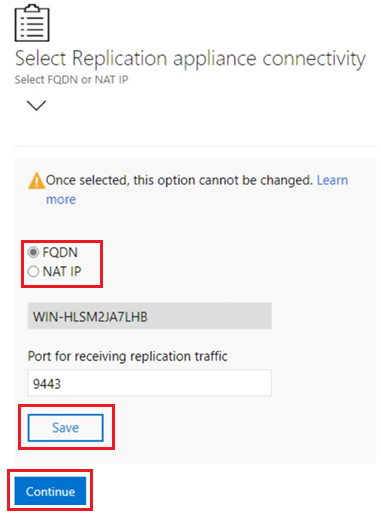 .
.After saving the connectivity details, select Continue to proceed with registration in Azure.
Ensure the prerequisites are met, and then proceed with the registration.
 .
.Friendly name of appliance: Provide a friendly name to track this appliance in the Azure portal under Recovery Services Vault infrastructure.
Note
The name can't be changed once set.
Azure Migrate replication appliance key: Copy the key from the portal's discovery screen.
 .
.After pasting the key, select Login. You're redirected to a new authentication tab. By default, an authentication code is generated on the Appliance Configuration Manager page. Use the following code in the authentication tab.
Enter your Azure credentials to complete the registration.
After successful registration, you can close the tab and return to the Appliance Configuration Manager to continue the setup.
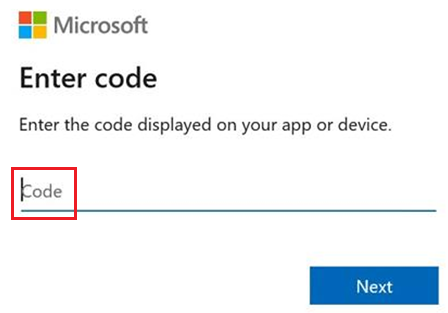
Note
An authentication code expires within 5 minutes of generation. If there is inactivity for longer than this duration, you're prompted to re-log in to Azure.
After successfully signing in, the details for Subscription, Resource Group, and Recovery Services Vault are displayed.
Select Continue to proceed.
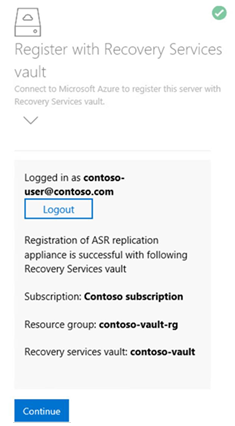 .
.After successful registration, proceed to configure vCenter details.
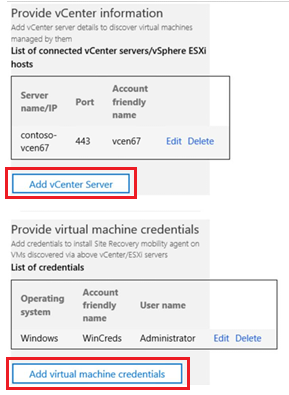 .
.Select Add vCenter Server to input the vCenter information.
Enter the server name or IP address of the vCenter, including the port number and then provide the username, password, and a friendly name.
This information is used to retrieve details about the virtual machines managed through the vCenter. The user account details are encrypted and stored locally on the machine. Learn more.
Note
If you're adding the same vCenter Server to multiple appliances, ensure that the same friendly name is used across all appliances.
After successfully saving the vCenter information, select Add Virtual Machine credentials to provide user details for the VMs discovered through the vCenter.
Note
- For Linux OS, ensure to provide root credentials.
- For Windows OS, a user account with admin privileges should be added. These credentials are used to push the installation of the mobility agent onto the source VM during the enable replication operation. The credentials can be chosen per VM in the Azure portal during the enable replication workflow.
- Visit the Appliance Configurator to edit or add credentials to access your machines.
After adding the vCenter details, expand Provide Physical Server Details to add information about any physical servers you plan to protect.
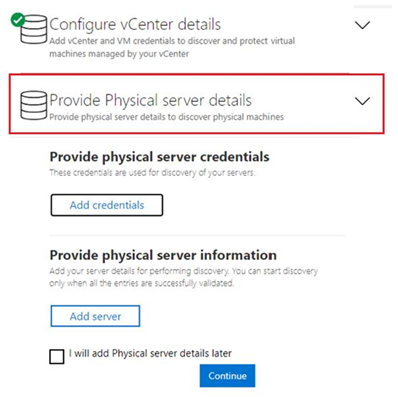 .
.Select Add Credentials to add the credentials of the machine(s) you plan to protect. Provide all necessary details, such as the Operating System, a friendly name for the credential, username, and Password. The user account details are encrypted and stored locally on the machine.
Finally, select Add.
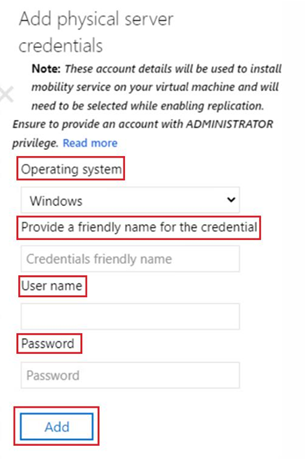 .
.Select Add Server to add the physical server details. Provide the machine's IP address or FQDN
Select the credential account, and then select Add.
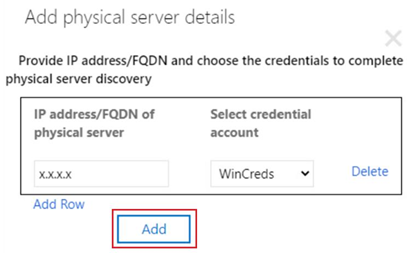 .
.
Install the Mobility service agent
When you enable replication for VMware virtual machines and physical servers, the Mobility service is installed on each on-premises machine. The Mobility service captures data, writes it to the machine, and forwards it to the Site Recovery process server.
You can install the Mobility service using the Mobility service agent software. The following methods are available for deployment:
- Push installation: When protection is enabled via the Azure portal, Site Recovery installs the Mobility service on the server.
- Manual installation: You can install the Mobility service manually on each machine through the user interface (UI) or command prompt.
- Automated deployment: You can automate the Mobility service installation with software deployment tools such as Configuration Manager.
Learn more about mobility service agent installation.
Replicate machines
Now, select machines for migration.
Note
You can replicate up to 10 machines together. If you need to replicate more, replicate them simultaneously in batches of 10.
In the Azure Migrate project, select Execute > Migrations > Replicate.
In Replicate, > Source settings > Are your machines virtualized?, select Physical or other (AWS, GCP, Xen, etc.).
In On-premises appliance, select the name of the replication appliance that you set up and then select continue.
In Guest credentials, select the friendly name of the credentials created previously during the replication appliance setup and then select Next: Virtual machines.
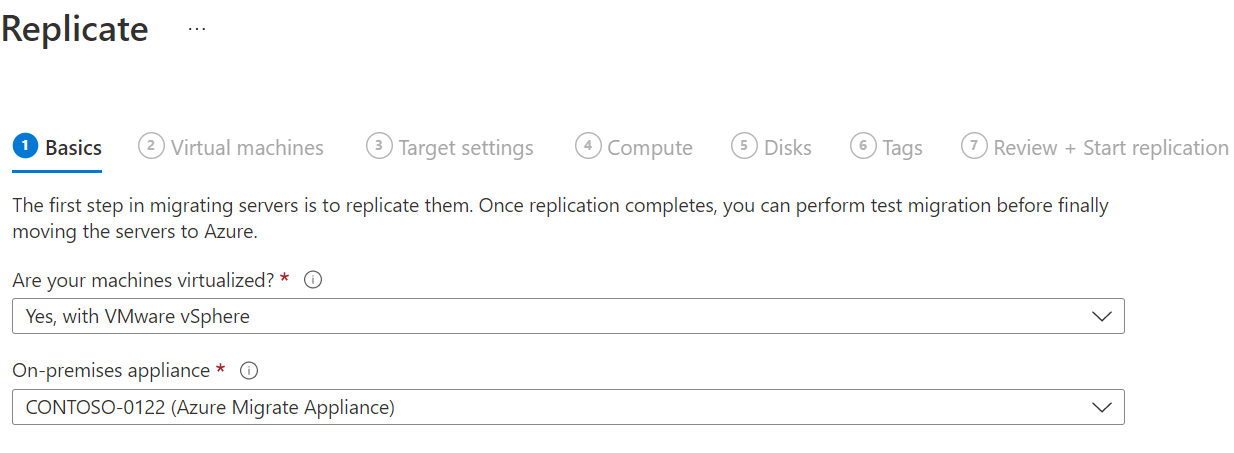
In Virtual machines, in Import migration settings from an assessment?, leave the default setting No, I'll specify the migration settings manually.
By default, VMs that are eligible for Trusted Launch are migrated as TVMs. Trusted Launch VMs provide enhanced security features such as secure boot and virtual TPM at no additional cost. We recommend using them wherever applicable.
Check each VM you want to migrate. Then select Next: Target settings.
In Target settings, select the subscription to which you'll migrate. (The region is set to your selection in the previous step and can't be modified.) Specify the resource group in which the Azure VMs will reside after migration.
In Virtual Network, select the Azure virtual network/subnet to which the Azure VMs will be joined after migration.
In Cache storage account, keep the default option to use the cache storage account that's automatically created for the project. Use the dropdown list if you want to specify a different storage account to use as the cache storage account for replication.
In Availability options, select:
- Availability Zone: Pins the migrated machine to a specific availability zone in the region. Use this option to distribute servers that form a multinode application tier across availability zones. If you select this option, you need to specify the availability zone to use for each of the selected machines on the Compute tab. This option is only available if the target region selected for the migration supports availability zones.
- Availability Set: Places the migrated machine in an availability set. The target resource group that was selected must have one or more availability sets in order to use this option.
- No infrastructure redundancy required: Select this option if you don't need either of the availability configurations for the migrated machines.
In Disk encryption type, select:
- Encryption-at-rest with platform-managed key.
- Encryption-at-rest with customer-managed key.
- Double encryption with platform-managed and customer-managed keys.
Note
To replicate VMs with customer-managed keys, you need to create a disk encryption set under the target resource group. A disk encryption set object maps managed disks to an Azure Key Vault instance that contains the customer-managed key to use for server-side encryption.
In Azure Hybrid Benefit:
- Select No if you don't want to apply Azure Hybrid Benefit. Then select Next.
- Select Yes if you have Windows Server machines that are covered with active Software Assurance or Windows Server subscriptions, and you want to apply the benefit to the machines you're migrating. Then select Next.
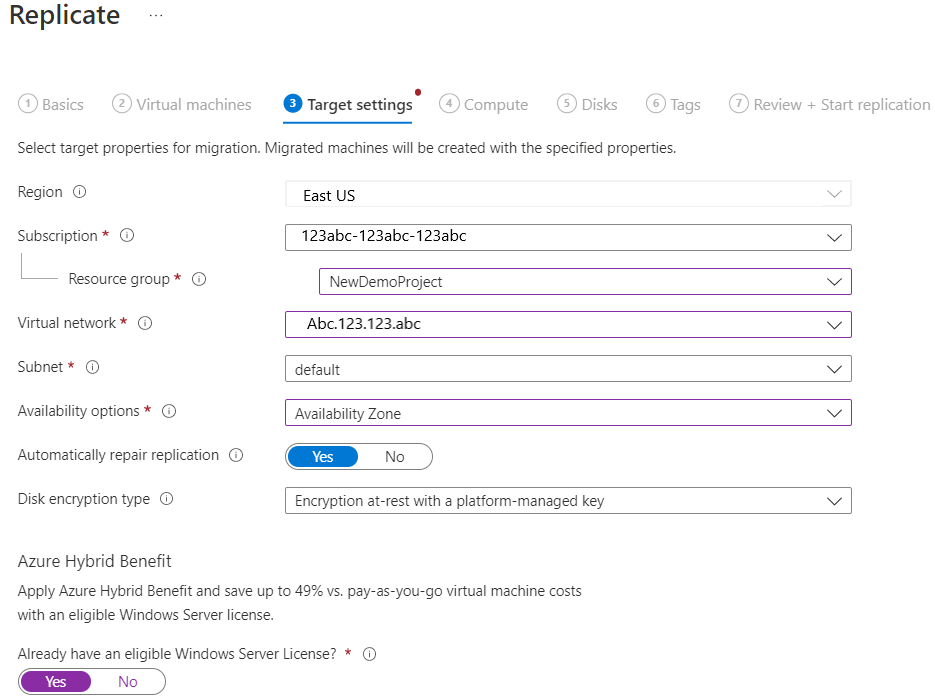
In Compute, review the VM name, size, OS disk type, and availability configuration (if selected in the previous step). VMs must conform with Azure requirements.
- VM size: If you're using assessment recommendations, the VM size dropdown list shows the recommended size. Otherwise, Azure Migrate and Modernize picks a size based on the closest match in the Azure subscription. Alternatively, pick a manual size in Azure VM size.
- OS disk: Specify the OS (boot) disk for the VM. The OS disk is the disk that has the operating system bootloader and installer.
- Availability Zone: Specify the availability zone to use.
- Availability Set: Specify the availability set to use.
- VM Security Type: Azure Migrate recommends migrating eligible VMs to Trusted Launch Virtual Machines (TVMs) for enhanced security. By default, the VM security type is set to Trusted Launch. VMs that are not eligible for Trusted Launch are automatically configured as standard security VMs.
In Disks, specify whether the VM disks should be replicated to Azure. Select the disk type (standard SSD/HDD or premium managed disks) in Azure. Then select Next.
- You can exclude disks from replication.
- If you exclude disks, they won't be present on the Azure VM after migration.
In Tags, choose to add tags to your VMs, disks, and NICs.
In Review and start replication, review the settings and select Replicate to start the initial replication for the servers.
Note
You can update replication settings any time before replication starts. Select Manage > Replicating machines. Settings can't be changed after replication starts.
Track and monitor
- When you select Replicate, a Start Replication job begins.
- After the Start Replication job finishes successfully, the machines begin their initial replication to Azure.
- After initial replication finishes, delta replication begins. Incremental changes to on-premises disks are periodically replicated to the replica disks in Azure.
You can track job status in the portal notifications.
You can monitor replication status by selecting Replications summary in the project under Migrations.
Run a test migration
When delta replication begins, you can run a test migration for the VMs before you run a full migration to Azure. We highly recommend that you do this step at least once for each machine before you migrate it.
- Running a test migration checks that migration works as expected, without affecting the on-premises machines, which remain operational and continue replicating.
- Test migration simulates the migration by creating an Azure VM using replicated data. (The test usually migrates to a nonproduction virtual network in your Azure subscription.)
- You can use the replicated test Azure VM to validate the migration, perform app testing, and address any issues before full migration.
To do a test migration:
In Migrations, select Replications summary and then select other under Replications.
In the Replicating machines tab, right-click the VM to test and select Test migrate.
In Test Migration, select the Azure virtual network in which the Azure VM will be located after the migration. We recommend that you use a nonproduction virtual network.
You can upgrade the Windows Server OS during test migration. To upgrade, select the Upgrade available option. In the pane that appears, select the target OS version that you want to upgrade to and select Apply. Learn more.
The Test Migration job starts. Monitor the job in the portal notifications.
After the migration finishes, view the migrated Azure VM in Virtual Machines in the Azure portal. The machine name has the suffix -Test.
After the test is finished, right-click the Azure VM in Replicating machines and select Clean up test migration.
Note
You can now register your servers running SQL Server with SQL VM RP to take advantage of automated patching, automated backup, and simplified license management by using the SQL IaaS Agent Extension.
- Select Manage > Replicating servers > Machine containing SQL server > Compute and Network and select yes to register with SQL VM RP.
- Select Azure Hybrid Benefit for SQL Server if you have SQL Server instances that are covered with active Software Assurance or SQL Server subscriptions and you want to apply the benefit to the machines you're migrating.
Migrate VMs
After you verify that the test migration works as expected, you can migrate the on-premises machines.
In the Azure Migrate project, select Migrationss > Replications summary and then select Other under Replications.
In Replicating machines, right-click the VM and select Migrate.
In Migrate > Shut down virtual machines and perform a planned migration with no data loss, select No > OK.
Note
For minimal data loss, we recommend that you bring the application down manually as part of the migration window. (Don't let the applications accept any connections.) Then initiate the migration. The server needs to be kept running so that remaining changes can be synchronized before the migration is finished.
You can upgrade the Windows Server OS during migration. To upgrade, select the Upgrade available option. In the pane that appears, select the target OS version that you want to upgrade to and select Apply. Learn more.
A migration job starts for the VM. Track the job in Azure notifications.
After the job finishes, you can view and manage the VM from the Virtual Machines page.
Complete the migration
After the migration is finished, right-click the VM and select Stop replication. This action:
- Stops replication for the on-premises machine.
- Removes the machine from the Replicated servers count in the Azure Migrate: Server Migration tool.
- Cleans up replication state information for the machine.
Verify and troubleshoot any Windows activation issues on the Azure VM.
Perform any post-migration app tweaks, such as updating host names, database connection strings, and web server configurations.
Perform final application and migration acceptance testing on the migrated application now running in Azure.
Cut over traffic to the migrated Azure VM instance.
Remove the on-premises VMs from your local VM inventory.
Remove the on-premises VMs from local backups.
Update any internal documentation to show the new location and IP address of the Azure VMs.
Post-migration best practices
For increased resilience:
- Keep data secure by backing up Azure VMs by using the Azure Backup service. Learn more.
- Keep workloads running and continuously available by replicating Azure VMs to a secondary region with Site Recovery. Learn more.
For increased security:
- Manage and govern updates on Windows and Linux machines with Azure Update Manager.
- Restrict network traffic to management endpoints with network security groups.
- Deploy Azure Disk Encryption to help secure disks and keep data safe from theft and unauthorized access.
- Read more about securing IaaS resourcesand Microsoft Defender for Cloud.
For monitoring and management:
- Consider deploying Microsoft Cost Management to monitor resource usage and spending.
Next steps
Investigate the cloud migration journey in the Cloud Adoption Framework for Azure.
Replicate machines
Now, select machines for migration.
Note
You can replicate up to 10 machines together. If you need to replicate more, replicate them simultaneously in batches of 10.
In the Azure Migrate project, select Windows, Linux and SQL Server > **Azure Migrate: Server Migration: > Replicate.
In Replicate, > Source settings > Are your machines virtualized?, select Physical or other (AWS, GCP, Xen, etc.).
In On-premises appliance, select the name of the replication appliance that you set up and then select continue.
In Guest credentials, select the friendly name of the credentials created previously during the replication appliance setup and then select Next: Virtual machines.

In Virtual machines, in Import migration settings from an assessment?, leave the default setting No, I'll specify the migration settings manually.
By default, VMs that are eligible for Trusted Launch are migrated as TVMs. Trusted Launch VMs provide enhanced security features such as secure boot and virtual TPM at no additional cost. We recommend using them wherever applicable.
Check each VM you want to migrate. Then select Next: Target settings.
In Target settings, select the subscription to which you'll migrate. (The region is set to your selection in the previous step and can't be modified.) Specify the resource group in which the Azure VMs will reside after migration.
In Virtual Network, select the Azure virtual network/subnet to which the Azure VMs will be joined after migration.
In Cache storage account, keep the default option to use the cache storage account that's automatically created for the project. Use the dropdown list if you want to specify a different storage account to use as the cache storage account for replication.
In Availability options, select:
- Availability Zone: Pins the migrated machine to a specific availability zone in the region. Use this option to distribute servers that form a multinode application tier across availability zones. If you select this option, you need to specify the availability zone to use for each of the selected machines on the Compute tab. This option is only available if the target region selected for the migration supports availability zones.
- Availability Set: Places the migrated machine in an availability set. The target resource group that was selected must have one or more availability sets in order to use this option.
- No infrastructure redundancy required: Select this option if you don't need either of the availability configurations for the migrated machines.
In Disk encryption type, select:
- Encryption-at-rest with platform-managed key.
- Encryption-at-rest with customer-managed key.
- Double encryption with platform-managed and customer-managed keys.
Note
To replicate VMs with customer-managed keys, you need to create a disk encryption set under the target resource group. A disk encryption set object maps managed disks to an Azure Key Vault instance that contains the customer-managed key to use for server-side encryption.
In Azure Hybrid Benefit:
- Select No if you don't want to apply Azure Hybrid Benefit. Then select Next.
- Select Yes if you have Windows Server machines that are covered with active Software Assurance or Windows Server subscriptions, and you want to apply the benefit to the machines you're migrating. Then select Next.

In Compute, review the VM name, size, OS disk type, and availability configuration (if selected in the previous step). VMs must conform with Azure requirements.
- VM size: If you're using assessment recommendations, the VM size dropdown list shows the recommended size. Otherwise, Azure Migrate and Modernize picks a size based on the closest match in the Azure subscription. Alternatively, pick a manual size in Azure VM size.
- OS disk: Specify the OS (boot) disk for the VM. The OS disk is the disk that has the operating system bootloader and installer.
- Availability Zone: Specify the availability zone to use.
- Availability Set: Specify the availability set to use.
- VM Security Type: Azure Migrate recommends migrating eligible VMs to Trusted Launch Virtual Machines (TVMs) for enhanced security. By default, the VM security type is set to Trusted Launch. VMs that are not eligible for Trusted Launch are automatically configured as standard security VMs.
In Disks, specify whether the VM disks should be replicated to Azure. Select the disk type (standard SSD/HDD or premium managed disks) in Azure. Then select Next.
- You can exclude disks from replication.
- If you exclude disks, they won't be present on the Azure VM after migration.
In Tags, choose to add tags to your VMs, disks, and NICs.
In Review and start replication, review the settings and select Replicate to start the initial replication for the servers.
Note
You can update replication settings any time before replication starts. Select Manage > Replicating machines. Settings can't be changed after replication starts.
Track and monitor
- When you select Replicate, a Start Replication job begins.
- After the Start Replication job finishes successfully, the machines begin their initial replication to Azure.
- After initial replication finishes, delta replication begins. Incremental changes to on-premises disks are periodically replicated to the replica disks in Azure.
You can track job status in the portal notifications.
You can monitor replication status by selecting Replicating servers in Azure Migrate: Server Migration.
Run a test migration
When delta replication begins, you can run a test migration for the VMs before you run a full migration to Azure. We highly recommend that you do this step at least once for each machine before you migrate it.
- Running a test migration checks that migration works as expected, without affecting the on-premises machines, which remain operational and continue replicating.
- Test migration simulates the migration by creating an Azure VM using replicated data. (The test usually migrates to a nonproduction virtual network in your Azure subscription.)
- You can use the replicated test Azure VM to validate the migration, perform app testing, and address any issues before full migration.
To do a test migration:
In Migration goals, select Windows, Linux and SQL Server > Azure Migrate: Server Migration, select Replicated servers under Replications.
In the Replicating machines tab, right-click the VM to test and select Test migrate.
In Test Migration, select the Azure virtual network in which the Azure VM will be located after the migration. We recommend that you use a nonproduction virtual network.
You can upgrade the Windows Server OS during test migration. To upgrade, select the Upgrade available option. In the pane that appears, select the target OS version that you want to upgrade to and select Apply. Learn more.
The Test Migration job starts. Monitor the job in the portal notifications.
After the migration finishes, view the migrated Azure VM in Virtual Machines in the Azure portal. The machine name has the suffix -Test.
After the test is finished, right-click the Azure VM in Replicating machines and select Clean up test migration.
Note
You can now register your servers running SQL Server with SQL VM RP to take advantage of automated patching, automated backup, and simplified license management by using the SQL IaaS Agent Extension.
- Select Manage > Replicating servers > Machine containing SQL server > Compute and Network and select yes to register with SQL VM RP.
- Select Azure Hybrid Benefit for SQL Server if you have SQL Server instances that are covered with active Software Assurance or SQL Server subscriptions and you want to apply the benefit to the machines you're migrating.
Migrate VMs
After you verify that the test migration works as expected, you can migrate the on-premises machines.
In the Azure Migrate project, select Windows, Linux and SQL Server > Azure Migrate: Server Migration, select Replicated servers under Replications.
In Replicating machines, right-click the VM and select Migrate.
In Migrate > Shut down virtual machines and perform a planned migration with no data loss, select No > OK.
Note
For minimal data loss, we recommend that you bring the application down manually as part of the migration window. (Don't let the applications accept any connections.) Then initiate the migration. The server needs to be kept running so that remaining changes can be synchronized before the migration is finished.
You can upgrade the Windows Server OS during migration. To upgrade, select the Upgrade available option. In the pane that appears, select the target OS version that you want to upgrade to and select Apply. Learn more.
A migration job starts for the VM. Track the job in Azure notifications.
After the job finishes, you can view and manage the VM from the Virtual Machines page.
Complete the migration
After the migration is finished, right-click the VM and select Stop replication. This action:
- Stops replication for the on-premises machine.
- Removes the machine from the Replicated servers count in the Azure Migrate: Server Migration tool.
- Cleans up replication state information for the machine.
Verify and troubleshoot any Windows activation issues on the Azure VM.
Perform any post-migration app tweaks, such as updating host names, database connection strings, and web server configurations.
Perform final application and migration acceptance testing on the migrated application now running in Azure.
Cut over traffic to the migrated Azure VM instance.
Remove the on-premises VMs from your local VM inventory.
Remove the on-premises VMs from local backups.
Update any internal documentation to show the new location and IP address of the Azure VMs.
Post-migration best practices
For increased resilience:
- Keep data secure by backing up Azure VMs by using the Azure Backup service. Learn more.
- Keep workloads running and continuously available by replicating Azure VMs to a secondary region with Site Recovery. Learn more.
For increased security:
- Manage and govern updates on Windows and Linux machines with Azure Update Manager.
- Restrict network traffic to management endpoints with network security groups.
- Deploy Azure Disk Encryption to help secure disks and keep data safe from theft and unauthorized access.
- Read more about securing IaaS resourcesand Microsoft Defender for Cloud.
For monitoring and management:
- Consider deploying Microsoft Cost Management to monitor resource usage and spending.
Next steps
Investigate the cloud migration journey in the Cloud Adoption Framework for Azure.
